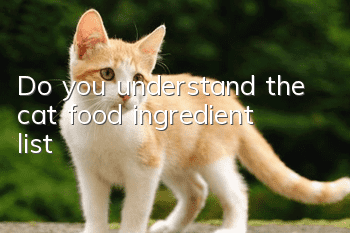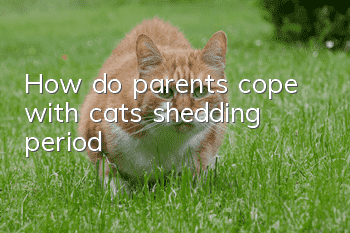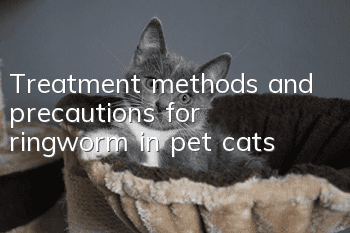Do you understand the cat food ingredient list?

Purchasing cat food has always been a headache for everyone. The raw materials and ingredient descriptions on the packaging are always confusing. This article mainly analyzes the raw material list of dry cat food.
Before analyzing the specific ingredients, let’s first figure out how the ingredient list on the cat food packaging is sorted.
According to the pet food packaging standards of The European Pet Food Industry and the instructions for pet food packaging of the U.S. Food & Drug Administration, the order of raw material composition is determined by its Determined by weight. The higher the ranking, the greater the weight proportion.
Screenshot source: The European Pet Food Industry
Screenshot source: U.S. Food & Drug Administration
Meat, meat powder
Meat is usually the main raw material of cat food, generally including chicken, fish, etc. Since cats are carnivores, their need for meat is indispensable. Meat raw materials are the main source of protein and other nutrients in cat food.
Meat meal is a dehydrated and dried meat component, usually required for the processing of dry food, and it is also a concentrated nutritional component. Sometimes, meat raw materials need to be processed and turned into meat powder before they can be mixed with other raw materials to make finished cat food.
The main nutrient contained in meat raw materials is protein. Protein is composed of various amino acids connected through long chains. After entering the cat's body, it is decomposed into the corresponding amino acids by enzymes. After being broken down into amino acids and absorbed in the small intestine, they can repair organs and tissues, carry molecules, transmit information between organs, and help the body resist disease.
In the raw material list of many dry foods on the market, meat meal as a meat raw material is often ranked second. Does this mean that the animal protein content of these products is not enough?
During the processing of meat meal, the meat raw materials will lose moisture and other components, and their weight will decrease, causing their order in the raw material list to drop. If meat meal is reduced to fresh meat, the amount used is greater than that of grain. In other words, under the premise of the same quality and weight, the protein content of meat powder is much greater than that of meat. It is a misunderstanding of dry food to think that animal protein content is low simply because meat meal accounts for less weight than grain.
What is “crude protein”?
Among the guaranteed values of component analysis of cat food packaging, there will be crude protein. The reason why it is written as crude protein is because modern technology cannot accurately detect the precise values of protein and other components. The data in the table are all calculated, so there is a term "crude".
Amino acids
Amino acids are derived from the decomposition of protein, and sometimes amino acids are added separately to cat food to achieve balance.
Among the many amino acids needed by cats, taurine is particularly important. Taurine is indispensable in any cat food. It is an organic acid widely distributed in animal tissues. Cats themselves have a weak ability to synthesize taurine and must obtain it through food. It can help cats improve their visual function, enhance their reproductive capacity, strengthen their heart muscle function, strengthen their nerve function and improve their immunity.
Animal oils and fats, vegetable oils
Animal fats usually include chicken fat, butter, fish oil, etc.
Vegetable oils usually include soybean oil, corn oil, etc.
For carnivorous cats, animal fats are indispensable, and the unsaturated fatty acids in vegetable fats are also very beneficial to them. Mixing these two oils in a scientific proportion can meet all the essential fatty acid needs of cat owners.
The main nutrient contained in oil is fat. Fat is an important component of animal organs and tissues. It can provide energy for cats and make their coats more shiny. The fat in cat food usually comes from meat, vegetable oils and animal fats.
What is “crude fat”?
Also because modern technology cannot accurately detect fat and can only roughly obtain its content through calculation, fat is written as "crude fat" in the ingredient list.
Vitamins
Vitamins in cat food usually include vitamins A, C, D, E, B, etc.
Vitamins are a type of trace organic substances that cats must obtain from food to maintain normal physiological functions., plays an important role in body growth, metabolism, and development.
Minerals
The minerals contained in cat food mainly include calcium, phosphorus, copper, iron, potassium, zinc, etc., which can promote metabolism, strengthen bones, and keep cats’ skin healthy.
Regarding the calcium to phosphorus ratio, why do the same products sometimes show different test results?
The correct calcium to phosphorus ratio in cat food is between 1:1 and 1.5:1. The scientific calcium to phosphorus ratio is very important for the bone development and health maintenance of cats. 90% of the calcium in the cat's body is found in the bones and teeth of the body. At the same time, calcium is also involved in the transmission of information between cells and the transmission of nerve impulses.
my country's "Determination of Calcium in Feed" stipulates two detection methods for calcium. The first is the potassium permanganate detection method, which is specifically noted as the arbitration method, which is relatively more accurate. The second method is the disodium ethylenediaminetetraacetate complex titration method, which is a rapid detection method. Compared with the first method, it is less accurate.
Different detection results for the same product may be due to the use of different detection methods.
Preservatives, antioxidants
Most cat foods, especially those that need to be stored for a period of time, contain preservatives such as potassium sorbate and BHA/BHT.
On the one hand, as a chemical additive, they are considered not natural enough; on the other hand, these preservatives and antioxidants are also important guarantees for food safety.
As a preservative and antioxidant, BHA/BHT has always been controversial. Although it is suspected to cause cancer, there is currently no scientific evidence that it is harmful within a safe dosage range, and it is still in the doubtful stage. BHA/BHT They are also widely used in human foods. Therefore, when you see BHA/BHT, you don’t need to panic too much.
Coarse ash
Coarse ash is the residue left after cat food is fully burned. It is mainly inorganic substances such as mineral oxides or salts. Less than 10% is usually a reasonable content ratio.
- Does a cat hold a grudge after being beaten?
- The appearance characteristics and naming principles of Shandong Lion Cat
- When did kittens stop being clingy?
- Does a cat grind its teeth when it bites people all the time?
- What can cats eat to gain weight?
- Is short-legged Manjikang a short-haired girl?
- Do cats know that humans are male and female?
- What medicine should a cat take when it sneezes? Solution to cat sneezing
- How long does it usually take for a cat to recover from a cold and sneezing?
- How long can a cat live with rickets?



